Former District Secretary Testifies
Today, August 22, 2016, former district secretary 2-TCW-850 (who remained anonymous due to ongoing investigations in other cases) provided information on purges in Baray District. For a large part of his testimony, he said he could not remember or did not know, but confirmed numerous excerpts that both the Co-Prosecution and the Defense Teams confronted him with. At the end of the last session, a new Civil Party was introduced, who told the Chamber about her experience of having been forced to marry under the Khmer Rouge regime.
Introduction of Witness 2-TCW-850
Today, witness 2-TCW-850 was heard via video-link. All parties were present, except National Counsel for Nuon Chea Liv Sovanna, who was absent due to personal reasons. Civil Party 2-TCCP-274 was on the reserve. The witness fell under the first category of E319/35 and was therefore only referred to under his pseudonym. The witness confirmed his identity as provided in a document presented to him.[1]
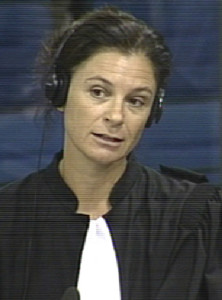
International Civil Party Lead Co-Lawyer Marie Guiraud
The floor was granted to the Co-Prosecution. International Co-Prosecutor Nicholas Koumjian asked about interviews he had given to Long Dany from DC-Cam and Thet Sambath. The witness confirmed having given these interviews. The video-connection was repeatedly interrupted, so Mr. Koumjian asked the technical unit whether they were able to fix the issue. In the meantime, remarks by Khieu Samphan Defense Counsel Anta Guissé were heard regarding the scope of charges of rape. She referred to the Civil Party Lead Co Lawyer’s request of March 18 2016 and asked whether a ruling on this would follow soon.[2] International Civil Party Lead Co-Lawyer Marie Guiraud explained that this request sought a simple clarification regarding the rape charges in the Security Centers S-21, Kraing Ta Chan, and Tram Kok Cooperative.
Mr. Koumjian then repeated his question about the interview with DC-Cam’s Long Dany. This interview opened with a question about the “good communication with people who were not Base People, what communication you had with them, and how you helped them”. He confirmed that he used to be a monk. He also used to be a militiaman fighting against the Lon Nol forces. He lived in S’ang District. He said he was assigned there in 1978. Mr. Koumjian said that he was assigned there in 1976. Mr. Koumjian read out an excerpt of the interview, in which he had said that he became Deputy Secretary of S’ang District, where he worked for one or two years, before being sent to Central Zone in July 1976.[3] The witness denied this. He said that he was still working in S’ang District then. Mr. Koumjian asked whether he worked in Taing Kok District as a secretary, which the witness denied. This prompted Mr. Koumjian to read out an excerpt of his interview again, in which he had said that he was the secretary and that he was prepared to play the interview. The witness said that he had not worked in Tram Kok District, which seemed to indicate that there was an interpretation error. He confirmed having worked in Taing Kok.
The witness also confirmed that he worked in Baray District.[4] Mr. Koumjian wanted to know who he replaced in Baray District, which the witness could not recall. The International Co-Prosecutor then read his answer in his interview: he had replaced a person called Moul.[5] The witness now confirmed this. He was in Baray District for about four to five months.
Taing Kok
He said he did not stay long in Taing Kok, and that he was the Deputy District Secretary. The District Secretary was Chorn (also spelled Choeun). He did not know what happened to him. Mr. Koumjian asked whether he meant Choeun alias Suor, which the witness did not know. Mr. Koumjian inquired whether a person called Thlork Cheav was there when he arrived. The witness denied this.[6] Mr. Koumjian read yet another excerpt of his interview, in which he had said that he became the secretary of Taing Kok District. The witness recounted that he was not the District Secretary from the beginning. He recounted that Moul was removed when he arrived and he himself became in charge of the district.
Mr. Koumjian confronted him with an excerpt of his interview. He had said that they would face death if they disagreed with something.[7] He replied that he referred to the “strict situation” at the time and that he became afraid of his own safety. He said that he “never sorted out the New People”, when Mr. Koumjian said that 17 April People and former soldiers were “sorted out”.
Mr. Koumjian quoted his interview. He had told the interviewer that he was given a list of people to be arrested, but that he had said that there was no opposition in his district.[8] The witness recounted that he “told them that there was no such thing”. He could not recall the interview with Thet Sambath. Mr. Koumjian read an excerpt of Thet Sambath’s book.[9] He now said that he could not recall having received such a list. Mr. Koumjian asked whether his deputies Chorn and Cheng were removed.[10] He said he could only recall Chorn. He was called for a study session by the sector and disappeared since then. “When they disappeared, it was clear they had issues”. Mr. Koumjian quoted his interview with Thet Sambath. The witness had indicated that “thousands of people” were executed as spies.[11] Mr. Koumjian quoted his interview with DC-Cam, in which he had said that the “upper level ordered us to take actions, including punishments or killings”.[12] He said he could not remember. He repeated that he could not remember having received such orders.
At this point, the President adjourned the hearing for a break.
Khmer Rouge Cadre in the District
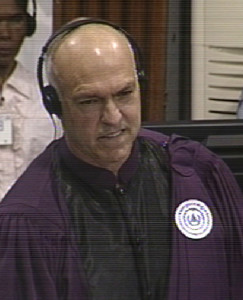
International Co-Prosecutor Nicholas Koumjian
Mr. Koumjian played the recording of the witness’s interview.[13] The witness confirmed that he recognized his voice. He said he could not recall what he meant when saying that they had to “sort out” people. When Mr. Koumjian played another recorded part of his interview, the witness said that “everything was as I said”. In this part of his interview, he had talked about receiving a list and telling other cadre that there was no opposition in his District. “But I still maintained my position that I would not do it, that I would not do it at all”. Chorn disappeared after they talked to him. Since earlier the witness could not remember the name of the deputy, Mr. Koumjian played another clip. After the clip was played, the witness said that person was called Tin, who was the member of the district committee. Mr. Koumjian quoted another excerpt, to which the witness replied that he was scared of his own safety.[14] Mr. Koumjian inquired whether he investigated and whether there was any reason for him to believe that there were people who were disloyal in Baray District. The witness replied that there were no disloyal people. He confirmed that he had talked about a funeral. He explained that his own safety was at risk. He confirmed that he would be killed if he resisted.[15] [16] Mr. Koumjian asked whether he recalled that people came to see him to find their relatives in Baray District, even years later after the regime ended.[17] The witness confirmed this and that one man came to look for his son, who had been a Khmer Rouge soldier. The witness could not remember Thet Sambath. He confirmed that he was in S’ang District, which belonged to Sector 25 under the Southwest Zone. There were two others: Chhorn and Kaeb. They were transported during the night time, but did not stop in Phnom Penh. They left in late afternoon. He knew a person called Prak, who was chief of the Sector. Prak came from Kandal Province. This person sent him to the Central Zone. Mr. Koumjian inquired whether he knew Pech Chim.
Mr. Koumjian then referred to Pech Chim’s interview, in which he had said that the chief of Taing Kok District was this witness.[18] He said that he could not recall whether Pech Chim came from Taing Kok. He could not remember the name Ke Pich Vannak[19] Mr. Koumjian read out Vannath’s interview, who had indicated that purges started after the Southwest group arrived in Baray District and that the witness was part. Mr. Koumjian asked whether it was true that thousands of people were arrested in his district. He replied that he heard people talking about this. He did not provide further information. He denied knowing Sao Van, who had been the governor of Taing Kok.[20]
Mr. Koumjian inquired whether he remembered people complaining about the deaths of people at a rubber plantation. He said he could not remember. He denied having attended study sessions in Phnom Penh. Nor did he attend study sessions with Nuon Chea. This prompted Mr. Koumjian to play another excerpt of his recorded interview, in which he had talked about meetings that were sometimes presided over by Nuon Chea. He confronted the witness why he was giving conflicting information now to the information he had provided in 2008: “Are you afraid?” The witness answered that he could not recall everything. Mr. Koumjian wanted to know whether he could not remember the disappearance of his colleagues. The witness answered: “Of course the memory cannot stay with us forever”. Mr. Koumjian inquired why he could not remember and asked whether he wanted forget about them, because he felt guilty. He replied that he simply could not remember. “As for the security center at Baray Chan Dek Pagoda, I was not aware of it”.
Former Khmer Rouge cadre Ban Siek had said that Baray district chief must have known about arrests.[21] The witness firmly denied this. Mr. Koumjian further confronted him with the testimony, in which Ban Siek had said that this witness “came from the Southwest” after the cadre from the Southwest had gone and that he must have known about it (October 5, 2015).
He insisted that he was not aware of it, since he worked there only briefly. “I went there late and I was not aware of everything. I was not.” Further, “I never conducted any investigations”. Mr. Koumjian pressed on and asked “Why were you concerned of your own safety?” He replied that he tried not to make any mistake: “I had to be very very careful in doing so during a regime that was considered a dark cloud”.
At this point, the President adjourned the hearing for a break.
Living Conditions under the Khmer Rouge
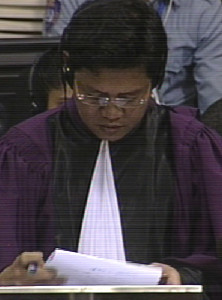
National Deputy Co-Prosecutor Seng Leang
After the break, Mr. Koumjian inquired about practicing religion, to which he answered that he had hidden having practiced religion. He replied that “under these circumstances” it was right to hide that he was a practicing Buddhist. He “felt concerned”. Mr. Koumjian wanted to know how he knew what was allowed and what was forbidden in the regime. He answered that he felt that this was beyond his knowledge. Mr. Koumjian inquired whether he met Pol Pot, Nuon Chea, or Khieu Samphan during the regime, which he denied. This prompted Mr. Koumjian to refer to Thet Sambath’s book and his interview, in which he had said that he met Pol Pot and Nuon Chea. With this, Mr. Koumjian concluded his line of questioning and handed the floor to his colleague Seng Leang.
National Deputy Prosecutor asked when he was transferred. He replied that it was in August 1978. He carried earth at Phnom Kabao. He went there once every day and carried soil four or five times. There was no inauguration of the worksite, but they had to complete it within one or two months. The worksite belonged to the sector. It “continued from 1st January Dam”. The person in charge of the sector was Ke Pauk. There were around 300 people on the worksite.[22] Initially, there were more people at the worksite. “And I told them that I would let them to visit their homes, their parents”. There were 5,000 or 6,000 people in the beginning. They issued the implementation of the plan based on months. They had two or three-month plans. He reported to the upper level. The workers stayed in tents or in makeshift cottages. Ke Pauk supervised the worksite.
Minor and Serious Offenses
The floor was granted to the Defense Team for Nuon Chea. Defense Counsel Doreen Chen explained that she would revisit many things that the Co-Prosecutor had discussed today. She quoted the witness’s interview.[23] He confirmed that he did not know the background of the people who worked at the worksite.
Ms. Chen then quoted another part of his interview, in which he had talked about offenses and punishment.[24] He confirmed that her understanding was correct. Light offenses were considered as misconduct that could be settled at the district level. He confirmed that coming in late for work would be considered a light offense. Ms. Chen asked whether she understood him correctly that the punishment for these offenses was to report them to the district and then re-educate them for two or three days, which he confirmed. Offenses that were determined as serious offenses did not occur in his area. Food poisoning and burning fields would be considered serious offenses.[25]
Oeun was the secretary.[26]
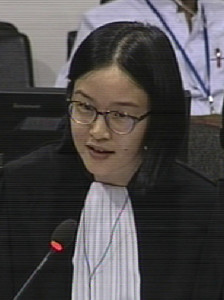
Nuon Chea Defense Counsel Doreen Chen
Ms. Chen asked whether he remembered attending a meeting at Baray District, in which the deputy secretary announced what kind of people would be considered to be enemies. He denied this, which prompted Ms. Chen to read out an excerpt. He then confirmed it and said that Dyn made this statement. He said that breaking of a plough would be considered offense. He had to make an announcement to the people.[27]
Ms. Chen asked him to ask more about his understanding of the upper echelon’s position. The livelihood of the people referred to the food that they received, he said. He learned of the position of the upper echelon through the announcement of the radio or through the messages delivered at the zone and sector level. As for meetings at the sector level, there were representatives from the sector and zone levels.
He could not recall an event where people were moved.[28] Ms. Chen quoted an excerpt, in which he had said that there were orders of the upper echelon to arrest people, which he had opposed.[29] He had told them that he did not have a full grasp of the situation. Oeun came from the Sector and visited the area around every twenty days. He denied being in contact with him during the times of his absence.
She referred to another excerpt, but he said that Oeun never showed him the list of people to be arrested.[30] Nothing happened to him when he refused to arrest these people. He explained that he never committed any wrongdoings.
After the least break, Ms. Guissé asked whether he remembered attending a meeting during which matters relating to the 17 April People were discussed, which he denied. To refresh his memory, she read an excerpt of his interview, in which he had said that he attended a meeting.[31] A document to that effect was used in the meeting. This was the first time he used a Revolutionary Flag.
Marriages
She then wanted to know when and where he attended a wedding ceremony. The witness could not recall the location, but could remember the event as such. He only attended one ceremony. There were two couples. Before the wedding, both sides had to make a proposal to their respective chiefs of cooperative chiefs. Once this was done “they would be fixed”. He confirmed that they both had to love one another, that their parents had to agree and that the wife had to have reached a minimum age of 18 years.[32] The cooperative had to verify the proposal. The request would be made to the district committee. The decision would be made in writing. After receiving such information, the district committee had to make a decision, which would be conveyed to the cooperative chief.
Cham
He confirmed that Cham families lived in his district, namely in Trapeang Chhuk.[33] He denied having received orders to arrest Cham. The Cham who were living there were the local villagers, he said. With this, Ms. Guissé concluded her line of questioning and the testimony of 2-TCW-850 came to an end.
New Civil Party: Forced Marriage
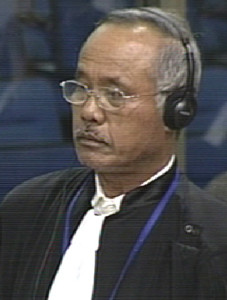
Civil Party Lawyer Hong Kim Suon
Judge Ya Sokhan ordered to usher in the next Civil Party, who was granted protection following the request by the Co-Investigating Judge not to disclose the Civil Party’s name.[34] The Civil Party confirmed her personal information indicated on a document. The floor was handed to the Lead Co-Lawyers for Civil Parties. Civil Party Lawyer Hong Kim Suon commenced his line of questioning by asking where she and her family lived before 1975. She replied that she lived in Unit 7 in 1975. She lived in Ta Ang Village, Ta Ang Commune, in Chamkar Leu District. She remained living in Village 7, Chamkar Leu District, Kampong Cham Province. She was with the chief of another unit. She was required to marry under the regime. She was married to someone else before the regime. This husband was “called to join the revolution”. She did not know clearly what happened to her husband. Her husband died, since “kong entered the country”. They had one child. This was in the beginning of 1977. When she got married, they told her only “at the scene”. Her workplace was called Unit 7. The chief of the unit, Chen, told her to get married. When she was called from Unit 7, there was a place that was called monti-knong (or knong office). Her husband was called Nhean. She learned his name later on. “I did not dare to protest any longer, because I observed that there were cases where people protested […] and they disappeared”. They were told that they would be send to “41”. She did not witness their arrests. “Initially I refused to get married, but because I was forced to get married, I had to agree”, she recounted.
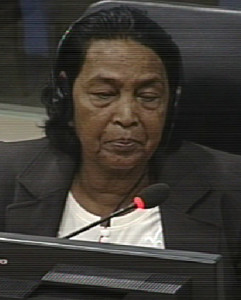
Civil Party
Comrade Phan chaired the ceremony and there were 12 couples who attended the wedding. The parents of the brides and grooms did not attend the ceremony. There was neither traditional Khmer music nor monks who blessed the couples. The tables were not decorated with flowers and there were simply the tables previously used by students in the school. The picture of the sickles was hung up behind the table. They served normal food. “It is not like the food nowadays”. She was “terribly worried” and did not want to get married to her husband. “I did not like him and I was so angry, I did not eat”. She was upset, because “he was not the guy I loved”. Mr. Kim Suon wanted to know whether she like dher new husband. She said she did not: “He had [an] ugly physical appearance. He had dark skin, and he spoke with [an] accent. He looked intimidating. I did not like him at all”. He did not walk properly. She was 23 or 24, and her husband was about 47 or 48 years old.
The ceremony took place between 5.30 and 6.30 pm. There was a lantern that had a handle.
The President adjourned the hearing. It will continue tomorrow at 9 am with the testimony of this Civil Party, followed by 2-TCCP-224.
[1] E3/9570, at 00893175 (KH), 00901043 (EN), 00974986 (FR)
[2] E306/7.
[3] E3/9149, at 00731242 (KH), 01101029 (FR), 01116146 (FR).
[4] E3/9149, at 01116147 (EN), 00731243-44 (KH), 01101030 (FR).
[5] E3/9570, at answer 3.
[6] At 01116146 (EN), 00731243 (KH), 01101029 (FR).
[7] E3/9149, at 00731244 (KH), 01101030 (FR), 01116147 (EN).
[8] E3/9149, at 00731253 (KH), 01101039 (FR), 01116153 (EN).
[9] E3/4202, Enemies of the People, at 00757529-30 (EN), 00849432 (FR), 00858335 (KH).
[10] E3/9149.
[11] E3/4202, Behind the Killing Fields, 00849432 (FR), 00858336 (KH).
[12] E3/9149, at 00731247 (KH), 01101033 (FR), 01116149 (EN).
[13] At 18:45.
[14] E3/19149, at 00731244, 01101030 (FR), 01116147 (EN)
[15] At 00 1246 (KH), 01101032 (FR), 01116148 (EN)
[16] Behind the Killing Fields.
[17] E3/9149, at 00731255 (KH), 01101040 (FR), 01116154 (EN).
[18] E3/9587.
[19] E3/35, at 00340565 (KH), 00367723 (FR), 00346152 (EN).
[20] E3/2073, at 00876419 (EN), 00892873 (FR), 00055197 (KH); at 00876423 (EN), 00892972 (FR), 00055201 (KH).
[21] E3/375, at 00360759 (EN), 00369922 (FR), 00348800 (KH).
[22] E3/9149, at 01116150 (EN), 007312493-94 (KH), 01101034-35 (FR).
[23] E3/9149, at 01116147 (EN), 00731244-45 (KH), 01101030 (FR).
[24] E3/5293, Written Record of Interview, at 00351705-06 (EN), 00348845 (FR), 00367752 (KH).
[25] E3/5293, at 00351705 (EN), 00367752 (KH).
[26] E3/9149, at 01116151 (EN), 00731250 (KH), 01101036 (FR).
[27] ibid.
[28] E3/4202, at 00757529 (EN), 00858335 (KH), 00849432 (FR).
[29] E3/9491, at 01116153 (EN), 00731253 (KH), 01101039 (FR).
[30] E3/4202, at 00757529 (EN), 00858335 (KH), 00849432 (FR).
[31] E3/5293, at 00367749 (FR), 00351703 (EN), 00348842-43 (KH).
[32] Ibid., at 00367751 00351705 (EN), 00348844 (KH).
[33] E3/1064, at answers 8-13.
[34] E319/7.
